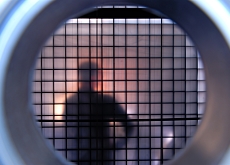
Finding the heavenly key

Researchers at the European Organization for Nuclear Research (Cern) in Geneva are looking at how radiation from outer space could be affecting our environment.
A new cutting-edge experiment aims to discover how exactly cosmic rays and the Sun may influence the formation of low-level clouds, and possibly climate change.
More than two centuries ago, the British Astronomer Royal William Herschel noted a correlation between sunspots – an indicator of solar activity – and the price of wheat in England. He suggested that when there were few sunspots, prices rose.
However, up until recently, there was little to back up this hypothesis. Today, inside an unassuming – some would say decrepit-looking – building at Cern, the Cloud (Cosmics Leaving OUtdoor Droplets) experiment might help explain how the Sun affects the climate.
It was a decade ago that Danish researchers first suggested that cosmic rays generated by exploding stars known as supernovas help generate low-altitude clouds.
The theory is that when this radiation penetrates the Earth’s atmosphere, it accelerates the formation of aerosols, or clusters of molecules, which may then grow to become the basis of cloud droplets.
A cloud with a larger number of droplets reflects the incoming sunlight more efficiently and lives longer, which produces a cooling effect. Experts say that variations of just a few per cent could have a significant influence on the Earth’s climate.
“We want to reproduce what happens in the atmosphere,” said Jasper Kirkby, leader of the Cern Cloud team. “We want to understand how you could get from a cosmic ray to a cloud droplet, and in which parts of the atmosphere this could be occurring.”
Since solar activity determines how much cosmic radiation reaches lower altitudes, any effect on clouds may explain how the Sun’s variability affects the climate.
Earth’s atmosphere
At Cern, a high-energy beam of particles mimicking cosmic rays is aimed at a so-called prototype reaction chamber, used to recreate the Earth’s atmosphere. The full detector, which will involve a more advanced reaction chamber and a cloud chamber, will not be ready until 2010.
By adjusting the chamber’s temperature and pressure, researchers can reproduce conditions found at different altitudes and latitudes, and hopefully determine which ones lead to aerosol formation.
The project was slow in getting off the ground. It’s taken almost a decade to overcome some preconceived ideas, as Kirkby explained.
“With an interdisciplinary experiment like Cloud, and a research topic a little ahead of its time,” he told swissinfo, “it was difficult to get the funding because it does not fit into a normal framework.”
Another problem is the ambient scepticism in the scientific community about a relationship between cosmic rays and climate.
“This link is not properly established for the moment,” said Urs Neu of the Swiss Forum for Climate and Global Change. “There is too much uncertainty about whether this radiation has an effect or not.”
Global warming
Another explanation may be a little more prosaic. Current models suggest greenhouse gas emissions are the prime culprits behind recent climate change, in this case global warming. Suggestions that currently unknown factors might play a role are not necessarily welcome.
“The cosmic ray theory has been used by people who want to deny human influence on global warming,” added Neu.
Nobody on the Cloud team is claiming that cosmic rays alone determine the environment. “If there really is an effect then it would simply be part of the climate change cocktail,” says Kirkby.
“What we want to understand is if, and by how much, this natural phenomenon contributes to the climate mix. We need to understand how clouds are affected to reduce the uncertainties from climate predictions.”
The first results of the Cloud prototype experiment are expected next summer, while data from the complete project should be available in 2010. In the meantime, the project team knows it can get on with its work.
“With so many people sceptical about this theory, we know we won’t be disturbed,” said Kirkby, who is, no doubt about it, perpetuating a long tradition of blue-sky research at Cern.
swissinfo, Scott Capper in Geneva
Cern was founded in 1954 by 12 states, including Switzerland, and now has 20 member states.
Around 6,500 scientists – roughly half the planet’s particle physicists – from around 500 institutes and universities have access to Cern.
Cern is currently building the Large Hadron Collider, to become operational in 2007. Costing SFr3 billion ($2.4 billion), it will be the world’s most powerful particle accelerator and is likely to change our fundamental knowledge of the universe.
The World Wide Web began as a Cern project called Enquire, initiated by British expert Sir Tim Berners-Lee in 1989.
The Cloud project involves an interdisciplinary team from 18 institutes and 9 countries in Europe and the United States.
These institutions include Switzerland’s Paul Scherrer Institute, the California Institute of Technology and Germany’s Max-Planck Institutes.
The experiment brings together atmospheric physicists, solar physicists, and cosmic ray and particle physicists.
It is also the first time a high energy physics accelerator has been used for atmospheric and climate science.

In compliance with the JTI standards
More: SWI swissinfo.ch certified by the Journalism Trust Initiative






























You can find an overview of ongoing debates with our journalists here . Please join us!
If you want to start a conversation about a topic raised in this article or want to report factual errors, email us at english@swissinfo.ch.